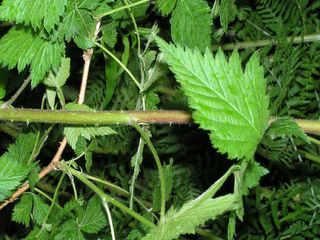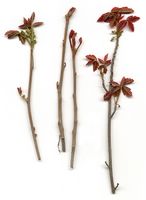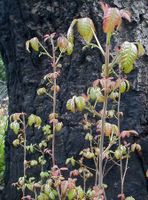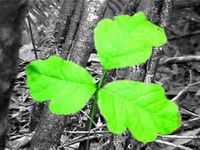It's that time of year again . . .
So imagine this. It is a great summer day out there. You have the forest all to yourself and it just feels great to hike without the tight, cinching binding of clothes. It's great to be naked after a week cooped up in that office. The breeze is gentle . . . the sun flickers off your uncovered skin as you wander slightly off-trail to enjoy the scenery. The caress of succulent verdant new growth kisses the skin of your legs and lower torso, tickling you . . . sensuous in it's own right. What could be better?
That is until a few days later when a rash starts to break out on strange places of your body and the intense itching starts.
Leaves of Three,
Leave it Be.
Berries White,
Poisonous Sight.
Western Poison Oak
Toxicodendron diversilobum (Rhus diversiloba)aka Pacific Poison Oak
- H 4’ or L 16’. Shrub or climbing vine. Leaves 6”, divided into 3 ovate, reddish-green, 3” leaflets, usu. toothed or lobed; turn crimson. Stems grayish. Flowers tiny, greenish white, clustered;
- Bloom Apr.–June. Berries tiny, white, striped, clustered.
- Caution Do not touch; even indirect contact (via clothes, pets, smoke) with any part can cause severe rash.
- Habitat Dry lowland forests and clearings.
- Range West of Cascades (local in WA up to 5,000 ft), Columbia R. Gorge.
So what were those plants you walked through? Poison Ivy and Poison Sumac are not much of a problem in the Cascades of the Pacific Northwest . . . but their cousin, Western (or Pacific) Poison Oak runs rampant around here . . . up and down the entire west coast and only checked by the deserts east of the Cascades and the Sierra Nevadas. You have to be prepared to recognize this plant in all it's variations and learn to deal with it. Sooner, rather than later, you WILL encounter poison oak.
For a naturist like myself, clothes are not going to protect us from poison oak (we aren't wearing any), and we have some rather sensitive parts exposed to a plant that needs only give up 50 mgs of urushiol resin to produce a rash of intense itching and blistering.
If you have a strong reaction to one member of the Toxicodendrons you will probably be very allergic to the others in the family. Cashews, mangos, and pistachios are commonly eaten cousins of the Toxicodendrons. If you have a severe reaction to the Toxicodendrons this does not mean that you will be allergic to these foods, but if you are allergic to cashews, mangos or pistachios, beware of poison oak! Your reaction could be severe. Some of us are blessed with a seeming immunity to poison oak. I'm one of them, having gone through a very severe case in my childhood. Still, I don't push my luck. I learn to recognize poison oak and how to deal with it in ways that minimize or eliminate contact with my bare skin. I use barrier creams and try not to disturb suspect plants when I pass nearby. Poison oak is a problem year round . . . the barren, upright stems will contaminate you in the middle of winter. But this time of year is when the plant grows vociferously and seemingly all over the place. Learn what to look for and the measures you can take to protect yourself.
The phenol resin from a bruised or damaged poison oak plant, urushinol, quickly oxidizes when exposed to air. This leads to a test for the presence of poison oak. If a leaf is placed between two white sheets of paper and the leaf is crushed, the wet spots will turn brown in a matter of minutes. Of course, be careful how you handle the pieces of contaminated paper now. Plastic bag it since we don't leave garbage laying around. Whatever you do, do not burn the paper as particles of urushinol could become airborne, settle on you or worse, you could breath them in.

Left: basket bush (Rhus trilobata), also referred to as squaw bush; center: poison oak (Toxicodendron diversilobum); right: Baja California poison ivy (T. radicans ssp. divaricatum). Note the enlongated center spine to the head leaflet!

The old adage about poison oak and poison ivy is quite accurate: "Leaves of three, let it be; berries white, poisonous sight."
Again, note the enlongated stem on the center trio of leaflets that distinguishes poison oak (and ivy) from the non-irritating look-alikes. Another distinguishing characteristic is the alternating placement of the leaflet trios on the stems of the poisonous varieties. Elderberry, for instance, looks just like poison oak except that the sets of leaflets oppose each other where they grow out on the stem.
Avoiding poison oak is sometimes hard to do when wading through lush foliage au' natural at this time of year. I won't get into the mechanics of how you get 'touched' other than to say that the resins (urushiol) are normally not present on the surfaces of undisturbed plants. It takes some bruising of the leaves or stems to release the resins. So if you must go through an area of poison oak (why, I don't know), step through gently and avoid disturbing the plants too much. Clothing up will keep the resins off your skin but keep in mind that now the poison is active and on your clothes and will remain so for a very long time, even after repeated washings. Bag these clothes seperately when you get a chance, careful to avoid the outside surfaces. This is a good reason to carry backup (and uncontaminated) clothing on those extended hikes . . .
The resin is a very sticky substance that remains active and in clothing for a very long time. Soap and water is your normal recourse but since the resins are 'tar-like' soap is not very effective in removing them before the urushiol penetrates the skin surface and provokes an allergic reaction.

Poison Oak washes and exfolliants claim to remove the resins before they can penetrate. Whether they work or not I haven't tested yet . . . the problem is, how do you know you have the resins on your skin. If you have a rash, it's already too late to wash them off. I prefer a barrier cream approach.

IvyBlock is a barrier lotion that shields your skin with a layer of bentonite clay that blocks urushiol. It is available over the counter in some drug stores. I get mine online.

A third product, Buji Block Poison Ivy-Oak Barrier Cream And Sunscreen from CVS.com touts to both provide sun protection and a barrier against poison oak at the same time. I haven't tried this product but it sounds promising.
Mother Nature's Solution: Jewel Weed . . .
Source: http://www.luminet.net/~wenonah/hydro/jewelwed.htm
Jewel Weed — "Touch Me Not" — Impatiens
This plant is a very effective Poison Ivy antidote.
 The Jewel Weed Stem should be crushed and the liquid rubbed into the skin contacted by the Poison Ivy and symptoms will not appear or will be much less troublesome.
The Jewel Weed Stem should be crushed and the liquid rubbed into the skin contacted by the Poison Ivy and symptoms will not appear or will be much less troublesome. Jewel Weed usually grows near water or in shallow ponds. It is often found in areas where Poison Ivy grows.
Jewel Weed totally neutralizes the Poison Ivy's oily antigen called Urushiol, and you will no longer spread it by scratching or rubbing. The Urushiol oil may be carried on the fur of pets, clothing, shoes, toys, tools, or other objects and then transferred to the skin. Approximately 24 to 36 hrs after a sensitized person is exposed to the Urushiol, a blistery, itching rash develops. Usually within 15 minutes of contact, the Urushiol binds to skin proteins. If it is washed off with soap and water before that time, a reaction may be prevented. After the antigen is fixed, however, it cannot be washed off or transferred to other areas. Scratching or oozing blister fluid cannot spread the antigen to other areas of the body or to other persons.
Jewel Weed is still quite helpful even if you have developed scabs, though you need to work — Rub — it in longer, and it takes time for the blisters to heal.
Take it from a guy — an Eagle Scout no less — who got carried away and made love in a Poison Ivy patch, — (with a woman who wasn't reactive) — this stuff really works and it works very fast, especially if you use it immediately.
Based on my personal experiences, tinctures made from the plant are only about 20% as effective as the fresh juice, and take much longer to work.
Jewel Weed is an effective natural herbal remedy not only for poison ivy, but also for poison oak, okra spines, stinging nettle, and other irritating plants; as well as bug bites and razor burn. Jewel Weed, is also used for acne, heat rash, ringworm and many other skin disorders.
A poultice made from the plant is an old folk remedy and is used for bruises, burns, cuts, eczema, insect bites, sores, sprains, warts, and ringworm.
Blackberry: What Poison Oak Is Not . . .

Blackberry is extremely common in the moister areas. Poison oak likes drier areas.

Thorns on the stems are a give-away. Poison oak has a smooth, woody stem.

It may appear to be three leaflets but is actually three seperate leaves (in the early growth spurt of this plant) that will grow together into the single, three-lobed leaf that we are familiar with blackberries.

Flowers are smaller and not tightly clustered like the distinctive 5-star flowerettes of poison oak.
What Poison Oak Actually Looks Like


The woody, upright stems are often a good clue to poison oak in the late fall and winter months, or of fresh growth in the spring.


The terminal leaflet has an enlongated stem as these pictures show. Look for that clue! Poison oak could also have five leaflets instead of the three we think of. Also look to see if the tri-leaflets alternate on the stem (poison oak) or emerge as opposing pairs.


The colors of the leaflets vary from shiny, thick and leathery in the full sun to thin and papery in shady areas. In early spring or late autumn the leaflets take on vibrant colors as this one does in the fall.


In woodlands poison oak often vines around trees, clinging with aerial rootlets. In clearings, poison oak commonly forms dense bushes characterized by the upright stems that clue us to this pest in winter. Yes . . . it can 'get' us in winter.


Views of the small, whitish to yellowish 5-pointed star flowerettes of poison oak. Poison oak flowers in April to June.





 The Jewel Weed Stem should be crushed and the liquid rubbed into the skin contacted by the Poison Ivy and symptoms will not appear or will be much less troublesome.
The Jewel Weed Stem should be crushed and the liquid rubbed into the skin contacted by the Poison Ivy and symptoms will not appear or will be much less troublesome. 
























|